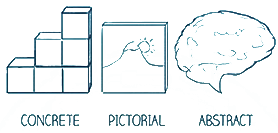Many students consider Math to be their most difficult subject and/or have unnatural apprehension about the subject. The numerous Math concepts, complicated word problems, and the use of algebraic symbols at higher Math, can seem daunting to students who do not have a strong mathematical foundation nor a holistic approach to learning Math. The Singapore Math program equips students with a plethora of computation techniques and problem solving strategies which they can use to “Make Math Come Alive”.
The Singapore Math curriculum uses the teachings of Jerome Bruner to help students develop computational techniques and strategies as well as strong problem-solving skills. Jerome Bruner (1915-2016) was an American psychologist whose research and work had a profound impact on the field of education. He established the Spiral Curriculum and the Constructivist Theory, which lead to the Concrete, Pictorial, Abstract (CPA) approach. Our educators use the CPA approach to develop a strong Math foundation in young learners and continue to use this approach to translate complicated Math word problems into visual models at higher Math. The Singapore Math students are excellent problem solvers who have the tools to apply creative solutions to challenging Math word problems.
Below, you will learn about Jerome Bruner’s contribution to education and how it pertains to the Singapore Math curriculum.
What Were His Key Contributions to Education?
Many of Bruner’s studies focused on early education and learning. Bruner believed that children could learn complex concepts from a very young age if the information was organized and taught appropriately. This led him to develop the three modes of representation:
The three modes of representation are at the heart of Bruner’s Constructivist Theory, which states that “students create their own knowledge.” This means students learn better when they use existing knowledge to create a solution to the problem at hand. Teachers should not provide students with the answers because that is not an effective way to learn.
Our Singapore Math educators understand that! We encourage students to use trial-and-error and past lessons to solve complex math problems. This helps to cultivate their problem-solving skills, setting them up for future success.
Jerome Bruner’s three modes of representation actually paved the path for the concrete, pictorial, and abstract (CPA) approach, which allows students to fully immerse themselves in the lesson and gain a better understanding of the problem at hand.
At Singapore Maths Club, we use the CPA approach to break down complicated math problems, making them easy to understand and straightforward. We begin by bringing the problem to life — students use physical objects to construct and solve the problem. This is the Concrete stage. Then, we progress to the Pictorial stage. In this stage, students use visual representations or diagrams to model the problem and come up with a solution. Finally, when students have a good understanding of the problem in the Concrete and Pictorial stages, they reach the last stage, Abstract, where they can solve problems using only mathematical numbers and symbols. Take addition, for example.
Using the three modes of representation also plays into Bruner’s Spiral Curriculum, the theory that learning should be revisited and built upon. The Spiral Curriculum suggests that:
- Students should revisit a topic multiple times throughout their educational careers.
- The complexity of the topic should increase each time it is revisited.
- New information builds upon old information, emphasizing the importance of having a strong learning foundation.
The Spiral Curriculum is an important part of Singapore Math, as we always aim to build upon previous knowledge. The basic math skills that students learn in Kindergarten will often be revisited to solve more complex problems. As a result, students gain a good understanding of mathematical concepts, and teachers don’t have to revisit old material frequently.
How Do We Use Bruner’s Teachings in Singapore Math?
Although Singapore Math was developed by studying the best educational techniques worldwide and combining them into one cohesive program, Bruner’s influence shines through. His Constructivist Theory, the CPA approach, and his Spiral Curriculum are the groundwork of the Singapore Math Enrichment Program.
Our team of educators helps to build a strong math foundation by using the CPA approach to teach computational strategies and techniques, problem-solving, algebraic thinking, language-processing, and more. Students develop a better understanding of mathematical concepts, which we then revisit and build upon. This helps improve mental math and develop creative problem-solving techniques.
